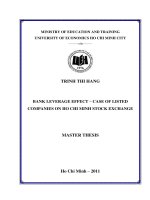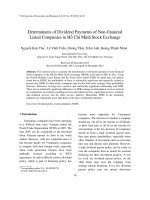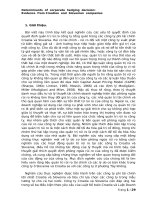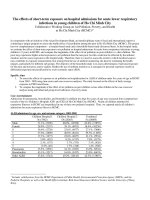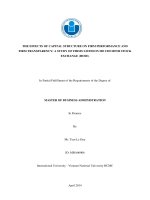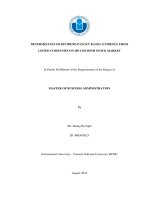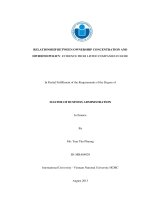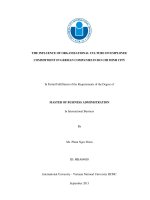Determinants of dividend payout ratio evidence from listed companies on ho chi minh stock market
Bạn đang xem bản rút gọn của tài liệu. Xem và tải ngay bản đầy đủ của tài liệu tại đây (1.11 MB, 88 trang )
DETERMINANTS OF DIVIDEND PAYOUT RATIO: EVIDENCE FROM
LISTED COMPANIES ON HO CHI MINH STOCK MARKET
In Partial Fulfillment of the Requirements of the Degree of
MASTER OF BUSINESS ADMINISTRATION
By
Mr. Hoang Ba Nghi
ID: MBA05025
International University - Vietnam National University HCMC
August 2014
DETERMINANTS OF DIVIDEND PAYOUT RATIOS: EVIDENCE FROM
LISTED COMPANIES ON HO CHI MINH STOCK MARKET
In Partial Fulfillment of the Requirements of the Degree of
MASTER OF BUSINESS ADMINISTRATION
By
Mr. Hoang Ba Nghi
ID: MBA05025
International University - Vietnam National University HCMC
August 2014
Under the guidance and approval of the committee, and approved by all its members,
this proposal thesis has been accepted in partial fulfillment of the requirements for the
degree.
Approved:
---------------------------------------------Chairperson
---------------------------------------Committee member
---------------------------------------------Committee member
---------------------------------------Committee member
---------------------------------------------Committee member
---------------------------------------Committee member
i
Acknowledge
This thesis report is about the Determinants of dividend payout ratios: Evidence
from listed companies on Ho Chi Minh Stock Market for the period of 2008-2012 would
not have been possible without valuable contribution of all teachers from school of
Business.
I would like to thank to the International University, Vietnam National University –
Ho Chi Minh City for giving us a great opportunity to practice and learn more
knowledge, especially in the field of finance. I especially appreciated the School of
Business that helped me have good condition to do the necessary research work and
archive the results.
I am deeply indebted to my thesis project advisor Dr. Nguyen Van Phuong, for his
patience, guidance and advice throughout this plan. He was always keeping his eyes on
my research. This gave me the efforts which proved valuable for the success of this thesis
project.
Finally, I would like to thank my parents, also my friends for supporting and
encouraging me throughout my studies. With their love, I could finish this work.
I hope this will serve as a valuable resource for whose major or carrier related to
this field.
ii
Plagiarism Statements
I would like to declare that, apart from the acknowledged references, this thesis
either does not use language, ideas, or other original material from anyone; or has not
been previously submitted to any other educational and research programs or institutions.
I fully understand that any writings in this thesis contradicted to the above statement will
automatically lead to the rejection from the MBA program at the International University
– Vietnam National University Ho Chi Minh City.
iii
Copyright Statement
This copy of the thesis has been supplied on condition that anyone who consults it
is understood to recognize that its copyright rests with its author and that no quotation
from the thesis and no information derived from it may be published without the author’s
prior consent.
© Hoang Ba Nghi / MBA05025 / 2014
iv
Table of Contents
Chapter One - Introduction .......................................................................... 1
1.1 General ideas ...................................................................................... 1
1.2 Rationale ............................................................................................. 3
1.3 Problem definition .............................................................................. 4
1.4 Objectives ........................................................................................... 5
1.5 Research questions ............................................................................. 6
1.6 Contributions ...................................................................................... 6
1.7 Scope and limitations ......................................................................... 7
1.8 Recommendation for future research ................................................. 8
1.9 Structure of the paper ......................................................................... 8
Chapter Two - Literature review ................................................................. 9
2.1 Definitions .......................................................................................... 9
2.2 Theories of dividend payment ............................................................ 10
2.2.1 Modigliani-Miller Dividend Irrelevance Theory ..................... 10
2.2.2 The “Bird in Hand” Theory ..................................................... 13
2.2.3 Signaling Theory...................................................................... 15
v
2.2.4 Agency Theory......................................................................... 17
2.3 Determinants of dividend payout ratio and hypothesis ...................... 19
2.3.1 Financial leverage .................................................................... 19
2.3.2 Investment ................................................................................ 20
2.3.3 Risk .......................................................................................... 20
2.3.4 Corporate income tax ............................................................... 21
2.3.5 Liquidity................................................................................... 22
2.3.6 Firm size................................................................................... 23
2.3.7 Structure of asset ...................................................................... 23
2.3.8 Sales Growth ............................................................................ 24
2.3.9 Cash flow ................................................................................. 25
2.3.10 Market – to – book value ....................................................... 25
2.3.11 Ownership concentration ....................................................... 26
2.3.12 Return on equity..................................................................... 27
2.4 Model for research.............................................................................. 29
2.5 Hypotheses ......................................................................................... 30
Chapter Three – Research Methodology ..................................................... 32
vi
3.1 Problem statement ............................................................................. 32
3.2 Research objectives ........................................................................... 33
3.3 Data ................................................................................................... 33
3.4 Research method ............................................................................... 35
3.5 Data analysis procedures .................................................................... 36
3.6 Data analysis types and methods ...................................................... 36
3.7 Sample collection and data analysis ................................................. 38
Chapter Four: Data analysis ......................................................................... 39
4.1. Sample description ............................................................................ 39
4.2. Panel data models ............................................................................. 41
4.2.1 Fixed effect – Hausman test ..................................................... 41
4.2.2 Checking correlation ................................................................ 43
4.2.3 Pooled OLS analysis ................................................................ 46
4.2.4 Testing multi-collinearity......................................................... 47
4.2.5 Linear regression with large dummy variables set .................. 49
4.2.6 Linear regression with lagged dependent variable................... 51
4.3 Discussion .......................................................................................... 54
vii
4.4 Answer research question ................................................................... 58
4.4.1 Question 1 ................................................................................ 58
4.4.1.1 Financial leverage ................................................................. 59
4.4.1.2 Return on equity.................................................................... 60
4.4.1.3 Corporate income tax ............................................................ 61
4.4.2 Question 2 ................................................................................ 61
Chapter Five – Conclusion ............................................................................ 64
5.1 Conclusion .......................................................................................... 64
5.2 Contribution........................................................................................ 65
5.3 Recommendation ................................................................................ 66
References .................................................................................................... 68
viii
List of table
Table 4.1 Descriptive Statistic from 2008 to 2012 .......................................... 40
Table 4.2 Hausman test result ......................................................................... 43
Table 4.3 Correlation matrix ........................................................................... 45
Table 4.4 OLS regression result ...................................................................... 47
Table 4.5 VIF result ......................................................................................... 48
Table 4.6 Linear regression with large dummy variables set result ............... 50
Table 4.7 Linear regression with lagged dependent variables ........................ 53
Table 4.8 Result comparison............................................................................ 55
Table 4.9 Comparison between empirical evidence and results...................... 56
ix
Abstract
The main purpose of this paper research is to find out the association between
dividend policy and financial leverage, investment, risk, corporate tax, liquidity, size,
structure of asset, sale growth, cash flow, market-to-book value, ownership
concentration, sale size, and return on equity of listed companies on Ho Chi Minh City
Stock Exchange (HOSE). The sample consisted of 301 listed firms on HOSE in five
years range, from the year of 2008 and 2012. The study is carried out in form of
quantitative research approach with a deductive method. And we have based on some
previous dividend theories including: the dividend irrelevance theory, the bird in hand
theory, the signaling theory and the agency theory. So as to examine whether it exists the
relationship between the selected factors and the dividend payout ratio, the paper uses
both an Ordinary least square (OLS) and a linear regression. Multi-collinearity tests were
also analyzed so as to prove that no multi-collinearity affected the results of the study
research. The result indicates that some of the selected determinants have an impact on
the companies’ dividend payout ratios. Especially, return on equity is the strongest
positive impact on dividend payout ratio.
Keywords: Dividend policy, Financial leverage, Investment, Risk, Corporate tax,
Liquidity, Size, Structure of asset, Sale growth, Cash flow, Market-to-book value,
Ownership concentration, Sale size, and Return on equity.
x
This page is intentionally left blank
1
Chapter One - Introduction
The main purpose of this first chapter is to provide a framework for this
research paper with details following in subsequent chapters. A major
component of the chapter is a statement of the research problem to be
examined in the following chapters.
1.1 General ideas
In corporate finance, dividend policy is paid much attention on. Based on the
business perspective, the dividend is a significant source of money to be settled
outside. For instance, in particular 1995, the listed companies on the New York Stock
Exchange had paid up the amount up to USD 130 billion of dividends for
shareholders. In terms of research, the dividend policy is a matter of controversy.
The question of whether businesses should pay dividends to shareholders or
retain that income to reinvest to other projects for earning more profit purpose
remains unclear. According to Lease (2000, p.29), the term of ‘dividend policy’ refers
to the practice that management follows in making dividend payout decisions.
Normally, dividend is defined as a sum of money from the company’s profits paid
commonly to investors. In another way, the dividend is the profit-sharing to the
company’s investors, compensating them back part of the capital. Likewise the
strategic options, the dividend is considered as an easy way for investors to get profit
from possessing stocks without trading them. Normally, the board of directors gives
the decision of how much should pay as dividend to the shareholders of a firm. The
matter of dividend payout ratio continues as one of the most challenging and dubious
issues in corporate finance and financial economies. The company can reinvest in
2
operations in future with the hope of creating more earnings, and market price of the
company in the future will be more appreciated. Either the company will payout a
certain percentage of profits to stockholders under the form of dividends. In the case
of the first option, the company should maintain consistent and instant growth to
demonstrate a convincing manner that the re-investment will generate a rate of return
for investors greater than receiving dividend.
In general, the company’s slow development means that the financing
opportunities in future are not appreciative, its stock price will not be increased much
more and the company should pay dividends to shareholders. The dividend enigma
has been an enduring problem in finance without being resolved. Allen, Antonio and
Ivo (2000) outlines the current harmony view when they come to the conclusion
“Although a number of theories have been put forward in the literature to explain their
popular presence, dividends remain one of the most enigmatic matters in corporate
finance”.
A few theoretical literatures on dividend payout policy have conciliated the
unquestionable logic of their dividend irrelevance axiom with the assumption that
both managers and markets recognize payouts either in stock or cash as form of
dividend. The academic work on this issue proposed five possible weaknesses that
management should consider, like as taxes, asymmetric information, incomplete
contracts, institutional constraints, and transaction costs (Allen et al., 2000). Previous
observational literatures have found out several determinants that are critical for
dividend payout policy. Lintner (1956) describes the dividend payment arrangement
of a corporation is substantially attributed to current year earnings (E0) and preceding
year dividends (Dt-1).
3
Pursuant by Modigliani and Miller (1963) theorem, the reaction of tax on
dividend payout policy has been examined a lot of literatures. Nonetheless, primary
experimental investigations have been checked through linked variables that are
necessary to describe and conclude what factors have remarkable impact on dividend
payout policy (Black and Scholes, 1974; Miller and Rock, 1985).
In general, developing firm holds retain earnings for its internal funding and pay
fewer dividends since in this concern the return on investment is high. Consequently,
it becomes an imperative issue of interest in financial literatures to investigate how
much to pay to the shareholders in cash or in stock. The former, that is, the cash
dividends are two ways to distribute cash to stockholders: stock repurchases or
dividends. Such dividends are paid out in cash and are usually taxable to the
beneficiary in the year they are paid. The latter, that is, the stock dividends are those
made payment in the form of supplementary stock/stocks of the issuing firm.
Commonly, stock dividends are issued in fraction to share owners. To support and to
have ideal measure of the factors analyzing dividend payout policy, the study consults
both cash and stock dividend. Several intellectual publications have pursuit to build
up theoretical models that managers should consider when making dividend payout
decisions. Only a little literature, especially for dividend determinants in Vietnam has
focused on empirical estimations.
1.2. Rationale
It is generally recognized that the particular choice of dividend payout by a
business at a given point of time has important implications for a variety of
considerations of significance to management, particularly those of future investments
and attraction of new equity capital.
4
Dividend, because of its nature of cash disbursement, is normally thought as
contributing to the opportunity for getting attention of current and potential investors.
Dividend policy is an important part of the financial policy of the enterprise as it has
not a direct impact on the benefits of the shareholders, but also influence on the
company’s development. Around the world, there are many different studies on
dividend policy, but it is still a problem even more controversial. Along with the
development of the Vietnam stock market, dividend policies of Vietnamese
enterprises increasingly play an important role. They have recently emerged as one of
the issues being much focused by investors, and businesses have not yet been acutely
highlighted the emphasis of the dividend policies of its financial activities, therefore it
has revealed some problems and shortcomings. This research hopes to get the real
picture being painted dividend policy of state enterprises in Ho Chi Minh City stock
market in the past five years and thereby points out the problem existing, as well as
issues rational proposals for market. Wishing to contribute for research importance
elements to the goal of maximizing shareholder assets , as well as further analysis of
dividend distribution decisions, I would like to choose the topic: " Determinants of
Dividend Payout Ratios: Evidence from listed companies on HOSE "to study science
subjects.
1.3. Problem definition
Companies can use internal or external sources to manage their investments.
Internal sources comprise retained earnings and depreciation, while external sources
radically indicate new borrowings or stock issue. Hence, the funding decision
comprises the evaluation of two choices. The first choice is the dividend choice (the
ratio of retained earnings to be reinvested and the ratio to be paid out as dividends).
5
The other is the capital structure choice – the portion of external finance to be
obtained and the portion to be raised in the form of new equity. There is an imperative
gap in modern finance theory on the issue of corporate dividend policy. The doctrine
should be able to explain the reason why dividends signal both “good” and “bad”
news.
For years, the term "information content of dividends" has been frequently used
in finance literature (Watts, 1973; Laub, 1976 and Venkatesh, 1989). The phrase
refers to the hypothesis which shows that dividends transfer information about future
interests - information that allows market participants to predict future earnings more
precisely. Lintner (1956) is one of the first to suggest that current dividends depend
on future as well as current and past earnings. Subsequently, a debate over the
dependence of a firm's market value on the degree at which dividends are paid out of
earnings (dividend payout rate) developed in the literature. Modigliani and Miller
(1963) demonstrated, under the premises of pure capital markets, rational behavior,
and duty-free, that the value of the firm does not rely on the firm’s dividend payout
rate. Previous studies being conducted on dividend payout do not agree that whether
payouts signal positive or negative conditions about a corporation (Watts, 1973).
Also, prior empirical evidence regarding the impact of dividend taxes on firm
valuation is mixed (Gentry, William, Deen, and Christopher, 2003).
1.4. Objectives
Thematic objective is based on the theories and practical evidences of dividend
policies around the world to reach the analysis and evaluation of the dividend policy
of listed companies on the HoChiMinh City stock market, which can be representative
6
for Vietnam stock market. Since then, a significance proposal is set up for building
appropriate dividend policy for the listed companies in the future.
Therefore, the research will mainly focus in declaring the following objectives:
To examine the factors that determine the dividend payout ratio in HOSE’s
market
To analyze the impact of proposed determinants on dividend payout ratio
policy.
1.5. Research questions
Thus, the research questions of this study are:
- What is the specific relationship between the dividend payout ratio and
selected factors for listed company in HOSE?
- Whether the degree of significance determinants on payout ratio policy is
homologous according to collected data?
1.6. Contributions
This research just adds a little bit of something to an already existing work, its
main target is to make a valuable contribution by innovating on the rich existing
literature. One of the proposed contributions of this paper is to investigate the
explanatory variable’s signs and their significance. An important usefulness of this
paper is to find out whether there are any significant differences in the parameter
values over the time period 2008 to 2012. Both theoretical and empirical approaches
are undertaken with the purpose to contribute a more comprehensive aspect on the
subject. Particularly, literature review is devoted to a review of previous theoretical
and experimental literature on the dividend decision controversy around the world.
This study attempts to innovate on existing academic work is by concentrating on
7
emerging, particular HoChiMinh City market, as opposed to developed. As noted in
the literature review part, less of the theoretical and observational studies that deal
with financing decisions are Vietnam based. Finally, the study builds decision models
of dividend policy in the business, and proposes appropriate selection dividend policy
for firms listed on the stock market in HoChiMinhCity.
1.7. Scope and limitations
The research is only the synthetic observations, analysis bases on data being
published in the mass media without the survey questionnaire of measuring the impact
of these factors to decide dividend policy of listed companies in Vietnam.
This study is for the listed companies in particular; all joint stock companies in
general, a proper level of awareness and rational importance of dividend policy and its
impact to value businesses through theoretical analysis. Therefore, this study ignores
many of the theoretical views of other dividends. For example: Brennan theory (based
on the model of capital asset pricing (CAPM), Brennan announces that pre-tax
income of a stock has the linear relationship with the systemic risk and the ratio
dividend, and the ratio dividend, higher pre-tax income is to offset the taxable
dividends that shareholders receive) or theoretical Elton and Gruber (given that the
reduction in the share price on the ex dividend low than the dividend per share).
This study remains obvious limitations being needed to be overcome,
supplement and deeper analysis to be more complete, more highly applicable to
partially contribute to the overall development of Vietnam stock market in the future.
8
1.8. Recommend for future research
Based on the literature explored, the paper aims to identify the factors determine
the dividend policy for companies on HoChiMinh City stock market. By studying
dividend policy of these companies using elements model, it is hoped to create a basis
for future study of dividend determinants of other industry in Vietnam too. The
subject can be extended by the analysis of other policies by stock dividend, buying
back shares and evaluating the combined effects of all of these dividend policies and
corporate values. The empirical findings have significant roles for operators and
policy makers to apply the same methodology to determine the determinants of
dividend policy factors of other industries in Vietnam.
1.9. Structure of the paper
Chapter 1: Introduction, presenting the foundation to set up the topic, problem
statement, objectives, scope, significance and contribution of the paper.
Chapter 2: Literature review, presenting theories, definitions related to
dividend policy, exposing model and research results of previous research related to
this topic. Suggesting research model for this paper.
Chapter 3: Research Methodology, presenting the research approach, the way
to take sample, measures, method of analyzing data.
Chapter 4: Data analysis, analyse the data and provides the descriptive
statistics table for all the regression variables.
Chapter 5: Conclusion, summarizing the research results of the topic -the
determinants of dividend payout based on companies listed on HOSE.
9
Chapter Two – Literature review
The main purpose of this chapter is examining historically significant
research studies that act as the basis for the proposed study. With a view to
implement the main purpose of this paper, the component problem
statements are identified as follow:
“Determinants of dividend payout ratios: Evidence from listed companies on
HCM Stock market”
This literature search is carried out to find materials relevant to dividend
payout ratios, and other determinants that have the relationship with such
as: financial leverage, investment, market-to-book value ratio, cash flow,
liquidity, ownership concentration, sales growth, firm size, return on equity,
corporate tax, risk, structure of asset. These materials include books, ebooks, materials issued by advisors and so forth.
2.1. Definitions
Investopedia defines “dividend payout ratio” as how well earnings approve the
dividend payments. In the U.K., they often use a similar ratio called dividend cover. It
is calculated as earnings per share divided by dividends per share. The dividend
payout policy is really one of the most controversial subjects within corporate finance
field and some scholastics treat the company’s dividend payout policy an unsolved
puzzle. Although a large scale amount of research regarding dividends has been
conducted, there is no homogeneous response for the question: what are the
determinants of the companies’ dividend payout ratios? There exist many reasons for
10
why companies should pay or not to pay dividends. For example, the dividend payout
is critical for investors because:
Dividends present certainty about the company’s financial welfare,
Dividends are attractive for investors looking for securing current income, and
Dividends help preserve market price of the share.
Companies that have an enduring past record of unchanged dividend payouts
would be negatively influenced by lowering or eliminating dividend distributions.
These companies would be positively influenced by upgrading dividend payouts or
making supplementary payouts of the same dividends. Moreover, companies without
paying a dividend in the past are perceived favorably when they inform new
dividends.
A decline dividends payout is looked badly by investors, and the stock price
usually decreases as investors pursue other dividend-paying stocks. An unfluctuating
dividend payout ratio illustrates a solid payout policy by the board of directors. The
dividend payout ratio supports an idea of how well earnings approve the dividend
payments. More grown-up companies favor to have a higher payout ratio.
2.2. The theories related to dividend payment
2.2.1. Modigliani-Miller Dividend Irrelevance Theory
Franco Modigliani and Merton Miller (1961) present one of the most influential
dividend theories and even though it is generated for more than 50 years ago, it is still
seen as one of the most respected theories. When the theory is presented in the article
“Dividend policy, the valuation of shares and the growth” it provides a new
11
benchmark and changes the view that both practitioners and academics have towards
dividends. Before the publication of Modigliani-Miller‘s dividend irrelevance theory,
the general view is that dividends are highly correlated to the value of the stock
(Baker, 2009, p.98). As the name of the theory suggests, it states that under perfect
capital markets, the dividend policy is liberated to the value of the company, and it
does not issue whether the company has high or low dividend payments. Modigliani
and Miller (1961) use three criteria in order to define a perfect capital market:
Perfect capital market - no single actor on the market is immense enough to
affect the market price of a guarantee security and everyone has entry to the
alike costless information, i.e. no actor has an information advantage. Another
important presumption is that there are no transaction costs or taxes and all
actors can operate on the market under the same conditions.
Rational behavior – it only states that all actors on the market prefer more
belongings to less. It also assumes that it does not matter whether the actors
receive the rise in revenue in the pattern of capital gains from the dividend or
stock payments.
Perfect certainty - all actors on the market has the same report and knows the
return of each security in the future.
Therefore, it is possible to make the assumption that there only exists security
which Modigliani and Miller assign to as stocks. In respect to the assumptions
discussed above, the dividend payments become irrelevant for the shareholders.
Because of paying dividends, the company has to issue new shares in order to raise
the needed capital. As the new stocks are issued, the price of the stocks will drop in
12
equal proportions to the dividend payments and the decrease in stock price and the
dividend payments will cancel each other out. For example, if the company pays a
dividend of 10 VND the shareholders receive 10 VND for each of the shares owned.
Simultaneously the stock price will decrease 10 VND since more shares are issued in
order to raise capital, the shareholders are therefore equally well off no matter the
dividend payments.
Modigliani and Miller also explain that the shareholders are capable of
constructing their own homemade dividends. Like for instance, if the company does
not pay dividends but the shareholder prefers 2 percent dividend he can sell 2 percent
of his stocks and thus creates a homemade dividend. The adverse is of course also
true, if the company pays a higher dividend than the shareholder prefers he can use
the surplus dividends to buy additional stocks (Brigham & Houston, 2011, p.484).
These two arguments discussed above are the underlying assumption of the
irrelevance hypothesis and according to these arguments shareholders should be
indifferent between capital gains and dividends. This in turn contributes to that the
shareholders are unwilling to pay a greater price for dividend paying stocks which in
turns make the question of dividends irrelevant. According to M&M theorem, under
perfect condition of capital market, the company’s dividend payout policies do not
influence the value of a firm. A number of previous research studies examine the
validity of Modigliani and Miller’s theories and the propositions have both been
supported and rejected by various academics. Black and Scholes (1974) favors the
results of Modigliani and Miller and states that companies are able to adjust dividend
payments in accordance with the preferences of tax-induced investors, and for this
reason there are no relationship between dividends and stock returns. Another
prominent research made by Miller, Merton and Scholes (1978) also maintain the
13
propositions in the dividend irrelevance theory and they identify that even though the
tax rate for dividends and capital gains are different under the US tax system the
dividends do not involve the value of the corporation.
2.2.2. The “Bird in Hand” Theory
The opposing view towards Modigliani and Miller’s dividend irrelevance theory
is that dividends affect the company’s value and this assumption is represented by the
so called “bird in hand theory”. The theory is first mentioned by Lintner (1956) and it
has been supported by various researchers including Gordon (1959&1962). Hence it
is one of the most well-known and respected dividend theories. The name “bird in
hand” is the umbrella term for all studies that argues that dividends are positively
correlated to the company’s value. Expressed in financial terms, the theory says that
investors prefer to invest in stocks that pay current dividend rather than to invest in
stocks that retain earnings and pay dividends in the future. This is because of the high
degree of uncertainty related to capital gains and dividends paid in the future. Current
dividends are more predictable than capital gains, as the stock price is ascertain by
market forces and not by the managers it has a higher degree of uncertainty (Keown,
Martin, Petty & Scott 2007, p.418).
Gordon’s (1962) dividend model is based on the following assumptions:
The company is all equity financed and no external financing is used. The
company finances all investment with retained earnings.
The retention ratio, cost of capital, and internal rate of return is constant.
The company has an eternal life.
